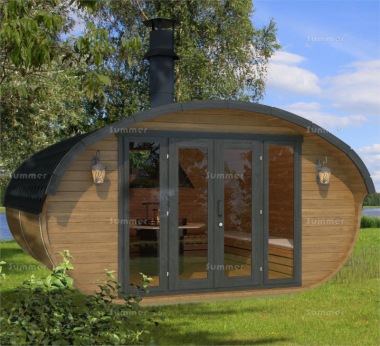Click this messge to hide it.
- All timber used in the construction of these buildings originates from sustainable forests
- External size 13'3" wide x 13'1" deep (4.05m x 4.0m)
- Sides and roof feature 42mm thick interlocking wall logs with rounded ball and socket stave joints
- Front and rear walls feature 28mm thick interlocking tongued and grooved wall logs
- 28mm thick timber floor panels are fitted inside the barrel
- Thermally modified timber wall logs (lifetime preservative treatment)
- Panoramic low level glazing
- Doors and windows glazed with annealed glass (no plastic, acrylic, styrene or perspex)
- Morticed and tenoned joinery door and windows
- Large glazed area in the front wall including double hinged doors and 2 non opening sidelight windows
- Front wall glazed area approximately 7'6" wide x 6'2" high (2.28m x 1.89m)
- Key locking doors
- 1 non opening window in the rear wall
- Decorative mineral felt tiles included in a choice of colours
- Strong steel barrel hoops
- 1 full length bench supplied to each side wall and to the rear wall
- Overall external height approximately 7'9" (2.35m)
- Front roof projection approximately 1'3" (0.37m)
- External width 13'3" (4.05m)
- External depth 13'1" (4.0m)
- Internal width approximately 13'0" (3.97m) at the widest point
- Internal depth approximately 11'6" (3.5m)
SCANDINAVIAN REDWOOD OR WHITEWOOD: The most widely used timber in the UK for years, Scandinavian Redwood and Whitewood grow in the well managed forests of Scandinavia and the coldest parts of Northern Europe. The cold climate ensures slow growth. The growth rings are much closer together than faster growing trees from warmer climates. As a result the timber is heavy and durable with a close grain pattern. The wood is seasoned and kiln dried to achieve the correct moisture content before it is machined. Redwood and Whitewood are so similar in appearance and performance that it is difficult to tell the difference. Both are classified as slightly durable and treatment is required for outside use. The forests of Scandinavia and Northern Europe have been responsibly managed on a sustainable basis for centuries so Scandinavian Redwood or Whitewood is an enviromentally friendly choice.
THERMALLY MODIFIED TIMBER: Thermally modified timber is a beautiful natural material with a projected service life of 30 years or longer. Only heat and steam are used in the treatment process and no chemicals are added. It is a lifetime preservative treatment. The timber is gradually heated to a high temperature which permanently changes the physical properties of the wood. The resistance to decay and stability of the wood are significantly improved as are the insulation properties. The moisture content is reduced and resin is removed so it cannot seep out of the wood. The process was developed in Finland but it is based on ancient knowledge. For example, the Vikings knew that fencing poles with a burnt surface were more durable. The finished colour of the wood is an attractive brown which can be painted or stained just like any other wood. If the wood is left untreated it will fade over time to a silver grey colour in the same way as other timber.
DECORATIVE FELT TILES: Mineral coated bitumen felt tiles are an attractive and durable roofing material which is far more hardwearing than standard roofing felt. Traditionally used for small buildings only in the UK, felt tiles are used much more in Scandinavia and North America where they are used widely in general housebuilding. The sophisticated design features a strip of almost dry bitumen adhesive. Over time each tile sticks to the tile below for improved waterproofing and windproofing. All fixings are covered by the next row of felt tiles, partly to ensure a neat appearance with concealed fixings but mainly to protect the fixing holes from any possible moisture. Mineral felt tiles are made using asphalt with a bitumen binder and an external covering of durable and attractive natural stone chips. Mineral felt tiles are often described as felt shingles because the design resembles traditional cedar shingles.
SIZES - LENGTH AND WIDTH: Sizes are sometimes rounded to the nearest nominal size for ease of reading but the correct external wall sizes are listed alongside the price. The first dimension listed is the width and the second dimension is the length. The width refers to the walls at the front and rear including the main door wall. The length refers to the curved side walls. The sizes listed are the overall external sizes. All sizes are approximate.


























